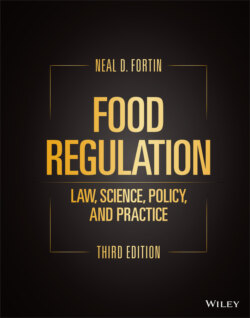Читать книгу Food Regulation - Neal D. Fortin - Страница 163
Safe Handling Instructions
ОглавлениеThis product was prepared from inspected and passed meat and/or poultry. Some food products may contain bacteria that could cause illness if the product is mishandled or cooked improperly. For your protection, follow these safe handling instructions.
Keep refrigerated or frozen. Thaw in refrigerator or microwave.
Keep raw meat and poultry separate from other foods. Wash working surfaces (including cutting boards), utensils, and hands after touching raw meat or poultry.
Cook thoroughly.
Keep hot foods hot. Refrigerate leftovers.
Mechanically Tenderized Beef Labeling Requirements 98
Tenderizing meat with a needle or blade can transfer pathogenic bacteria from the exterior of the meat to the interior. While intact muscle cuts, such as steaks, can be safe when cooked rare or medium rare because the outside is seared, the mechanically tenderized cuts must be cooked all the way through, like ground beef products, to kill pathogens inside the meat. CDC outbreak data from 2010 to 2014 indicates that consumers and food service facilities sometimes do not cook mechanically tenderized raw beef products to a temperature and for a time sufficient to destroy harmful bacteria that may have been transferred to the tenderized interior of the product.99
However, not all mechanically tenderized products are readily distinguishable from nontenderized products. For this reason, FSIS requires labeling to state that a beef product has been mechanically tenderized along with validated cooking instructions to provide consumers and food service workers the essential information to safely prepare the product.100
The name of raw or partially cooked mechanically tenderized beef must clearly indicate that the product has been mechanically tenderized. The terms “needle tenderized” or “mechanically tenderized” may be used as the descriptive designation for needle tenderized beef and the terms “mechanically tenderized” or “blade tenderized” may be used as the descriptive designation for blade tenderized beef. There are also type size, clarity, and prominence requirements in the labeling rule.101
The labels must also include validated cooking instructions, including the minimum internal temperatures and any hold times, so that consumers know how to safely prepare the products. FSIS released an updated guidance for the use of federally inspected establishments in developing validated cooking instructions for mechanically tenderized products. FSIS predicts that the changes resulting from the new rule will prevent hundreds of illnesses per year.
The new rule applies only to mechanically tenderized beef, and not to tenderized poultry or other nonbeef products. Although FSIS considered this option, the agency concluded that there are insufficient data on the production practices and risks of consuming those products.
